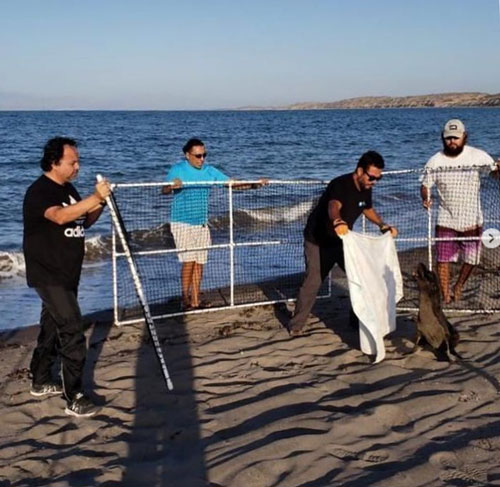
Rescue in progress! The techniques used to capture
and restrain
a stranded or injured animal require teamwork.
Marine Life in Distress
Whales, Dolphins, and Porpoises (cetaceans) are considered stranded when they are found dead, either on the beach or floating in the water, or alive on the beach and unable to return to the water.
Seals and Sea Lions (pinnipeds) are considered stranded when they are found dead on land or in the water, or are in need of medical attention. Because healthy pinnipeds come on land to rest, expert assessment may be needed to determine if they need help.
Sea Turtles when stranded are defined as any ocean turtle found on land or in the water that is dead, injured, or exhibits any indication of ill health or abnormal behavior.
Live-stranded animals usually need medical attention or professional assistance to return to their natural habitat. La Paz's Mexico Marine Wildlife Rescue Center is the only rescue center of its kind in Mexico and is solely devoted to the rescue, rehabilitation and release of stranded, injured, sick, and entangled marine wildlife. MMWRC is a non-profit organization here in Mexico (A.C.) and the sister organization to Museo de la Ballena. MMWRC is 100% volunteer operated and funded by public donations.
Because we are always on the water the La Paz cruising fleet has the opportunity to help the rescue center by reporting any stranded animals. If you spot a stranded animal follow these guidelines:
Observe From a Distance
Stay 50 ft or more away from the animal and observe. Is this animal in distress or could these be normal behaviors? Take a little time to observe and be ready to relay this information. Any sign of injury? Entanglement? A colored tag?
Do Not Touch
Do not approach or touch the animal. If the animal reacts to your presence it means you are already too close and causing it stress. If it does not react, it may mean its' condition is so poor that it doesn't have the energy. For your safety and theirs, maintain your distance and keep other people and dogs (on leash) away from the animal by creating a virtual perimeter.
Take Photos
A picture is worth a thousand words! Get pictures of the animal, where it is in relation to its' surroundings, and any injury or debris attached to the animal. Short videos can also be very helpful.
Determine the Exact Location
Use your boat's nevigation device or the compass app on your smart phone to get the lat long of your location. Otherwise do your best to give clear directions to the location, including mile markers, beach name, or landmarks.
Report the Incident
Call the Mexico Marine Wildlife Rescue Center rescue hotiline (Call or Whatsapp) +52 612 214 3750. You may also email the information to Mexico Marine Wildlife Rescue Center at rescue@mmwrc.org or rescate@mmwrc.org.
Help Rescuers
If you are able to stay at the scene, please do. You can help direct rescuers to the animal's exact location. Many beaches and coastlines have restricted access and miles of open space with little or no landmarks. If the spot is hard to find, it may be helpful to drive or walk to the nearest intersection or landmark to lead rescuers to the correct location. This type of help can be critical in emergency rescue situations.